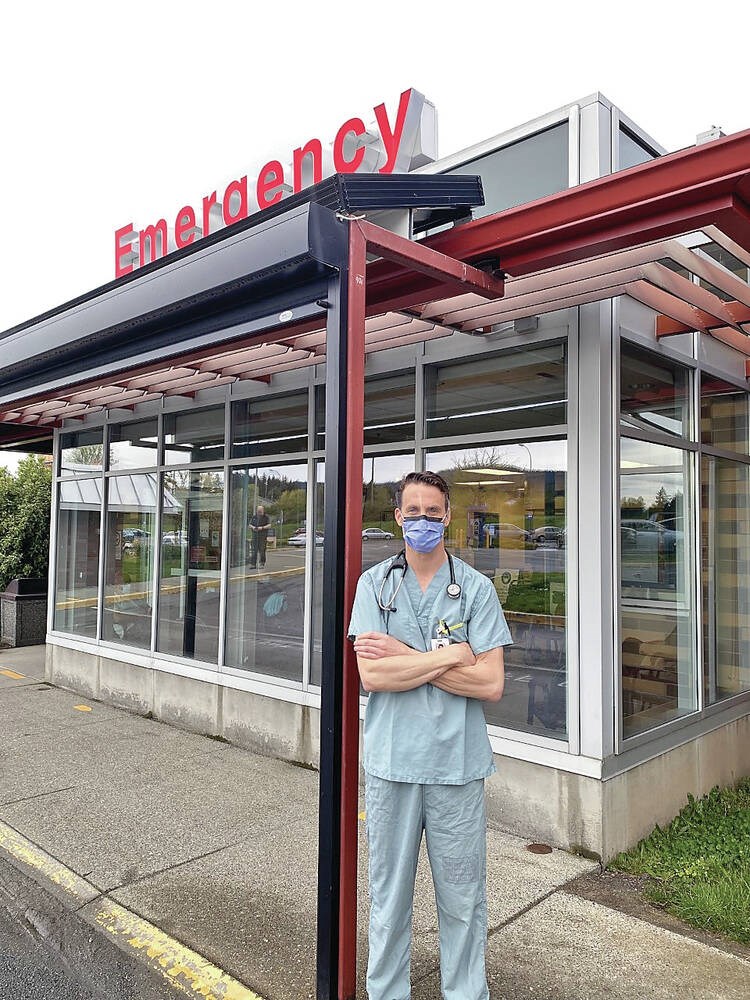Emergency physician talks about medical system under stress
Region’s hospitals are operating beyond capacity, walk-in clinics full within hours of opening
^
Dr. Jeff Unger had two shifts in a single day in the emergency department of Saanich Peninsula Hospital last week in a month marked by hospitals at or over capacity and walk-in clinics full within hours of opening.
Unger responded to a “crisis call in” on April 26 to work a partial day shift in Saanich Peninsula ER until 5 p.m., went home for a nap, and returned for his scheduled night shift at 11:30 p.m.
A “crisis call in” is made to support patient safety when, for example, there is excessive ER volume and the cases are complex.
“These used to be a relatively rare occurrence — three to four times a month — but are happening nearly daily now,” said Unger. “I did one last week as well, as many in our group of 18 regular physicians are already working more than they wish and burning out.”
It’s the same for nurses, said Unger, who regularly works overtime to respond to an almost daily need to fill understaffed shifts and uncovered shifts due to staff illness.
One veteran ER nurse recently worked 25 night shifts in one month to try to ensure safe patient care, said Unger. Other staff, including unit clerks, those working in labs and imaging departments, and cleaners are also under pressure, he said.
B.C. Nurses’ Union vice president Adriane Gear said it’s no secret hospitals in southern Vancouver Island have been over capacity.
Hospitals are short of nurses, short of GPs, and are receiving patients who would likely not be in emergency rooms if they had a family doctor, she said.
At Saanich Peninsula recently, more than half, and at times all, of the ER care spaces were occupied by admitted patients, Unger said. When there’s a backlog of people in emergency waiting to be admitted, it means those emergency beds are not available for new patients.
Providing quality care in the emergency department is compromised when staff are forced to use administrative spaces, decontamination and storage rooms, hallways and the waiting room to see a majority of emergency room patients, said Unger. It’s an added challenge to protect patient privacy, confidentiality and dignity.
It’s this type of situation that forced Island Health to divert ambulances from Saanich Peninsula to Victoria General Hospital for 45 minutes on April 24 “as there were no more monitored beds available and we had several critically ill patients,” said Unger.
B.C. Health Minister Adrian Dix told reporters last week the province has been dealing with “capacity issues in our hospitals now for a couple of years.” The health-care system was operating at 155 per cent capacity at times prior to the pandemic, he said. That means base beds were full, requiring the use of overflow or “surge” beds.
There are 9,229 base beds in the B.C. health care system and 2,353 surge beds, said Dix.
Dix said this week it continues to be an extremely challenging time in health care given the dual pandemic and opioid-overdose health emergencies but assured patients that hospitals on Vancouver Island continue to be ready to serve patients.
Island Health has also said hospitals are “extremely busy” but “we want to reassure the public that we are open and ready to take care of anyone who shows up in need of care.”
Health authorities don’t want people who need emergency care to refrain from visiting ERs because of reports that hospitals are busy.
Island Health administration is working “incredibly hard each day stamping out these overcapacity fires, and rearranging insufficient human and physical resource chairs on the deck of our sinking system,” said Unger.
Frontline staff feel somewhat helpless to effect meaningful change given the larger system issues that need provincial and federal interventions, said Unger.
The emergency department serves as a barometer for the success or failure of care in the community — primary care, chronic care, long-term care, said Unger.
In March and April of this year, emergency visits are up about 20 per cent compared to annual increases of about six per cent in pre-pandemic years, Unger estimated.
The time patients spend in emergency waiting for a ward bed now averages over 24 hours, up by 110 per cent, compared to 2019-2020, he said.
Meanwhile, over the course of the current contract, emergency physician staffing has increased about 15 per cent while patient volumes have increased nearly 85 per cent, he said. “The Ministry of Health and health authority will not properly fund our emergency department so that we can hire more physicians.”
Unger said he is speaking up “as it genuinely seems to me now that our health care system, locally and nationally, is truly in crisis.”
He said the many problems include: years of poor human resource planning and program funding, poor emergency room staffing, insufficient home and community care supports for seniors, poor access to primary care for preventive and chronic care management, poor access to walk-in clinics, inefficient use of telemedicine and urgent and primary care centres, and the lifting of mask and proof of vaccination mandates.
“I see more patients with COVID through the ED now than at any other time in the pandemic,” said Unger. Patients with long COVID who don’t have a family doctor are also coming in.
An independent COVID-19 modelling group says B.C. is in a sixth wave that has not peaked yet.



